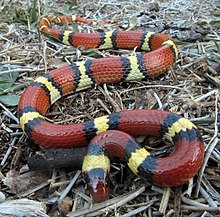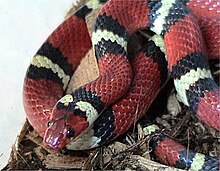
The milk snake or milksnake, is a species of kingsnake; 24 subspecies are currently recognized. Lampropeltis elapsoides, the scarlet kingsnake, was formerly classified as a 25th subspecies, but is now recognized as a distinct species. The subspecies have strikingly different appearances, and many of them have their own common names. Some authorities suggest that this species could be split into several separate species. They are not venomous to humans.

Kingsnakes are colubrid New World members of the genus Lampropeltis, which includes 26 species. Among these, about 45 subspecies are recognized. They are nonvenomous and ophiophagous in diet.

Coral snakes are a large group of elapid snakes that can be divided into two distinct groups, the Old World coral snakes and New World coral snakes. There are 27 species of Old World coral snakes, in three genera, and 83 recognized species of New World coral snakes, in two genera. Genetic studies have found that the most basal lineages have origins in Asia, suggesting that the group originated in the Old World. While new world species of both genera are venomous, their bites are seldom lethal; only two confirmed fatalities have been documented in the past 100 years from the genus Micrurus. Meanwhile, snakes of the genus Micruroides have never caused a medically significant bite.

Lampropeltis triangulum campbelli, commonly known as the Pueblan milk snake or Campbell's milk snake, is an egg-laying subspecies of non-venomous colubrid snake. It is commonly bred in captivity and is found in several color variations. When handled, it can discharge a pungent-smelling exudate from its cloaca as a presumed defense mechanism.
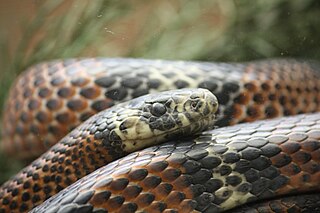
Lampropeltis triangulum andesiana, commonly known as the Andean milksnake, is an alpine subspecies of milk snake.

Cemophora coccinea copei, commonly known as the northern scarlet snake, is a subspecies of harmless colubrid snake that is native to the southern and eastern United States.
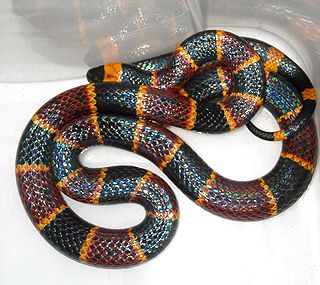
Micrurus fulvius, commonly known as the eastern coral snake, common coral snake, American cobra, and more, is a species of highly venomous coral snake in the family Elapidae. The species is endemic to the southeastern United States. It should not be confused with the scarlet snake or scarlet kingsnake, which are harmless mimics. No subspecies are currently recognized.
Kenneth Lee Williams was an American herpetologist and author of books on the subject of snake biology and classification. Williams retired from teaching in Northwestern State University's biology department and received emeritus status in 2001. Williams is considered an authority on the milk snake and the herpetology of the Honduran Cloud Forest.

Lampropeltis getula, commonly known as the eastern kingsnake, common kingsnake, or chain kingsnake, is a harmless colubrid species endemic to the United States and Mexico. It has long been a favorite among collectors. Nine subspecies are currently recognized, including the nominate subspecies described here.

Cemophora coccinea coccinea, commonly known as the Florida scarlet snake, is the nominotypical subspecies of the scarlet snake. It is a nonvenomous colubrid snake that is endemic to the southeastern United States.

Lampropeltis triangulum hondurensis, commonly known as the Honduran milk snake, is an egg-laying subspecies of nonvenomous colubrid snake. It is one of the more commonly bred milk snakes in captivity and is one of the larger milk snakes, reaching a length of 5 feet.
Caryospora is a genus of parasitic protozoa in the phylum Apicomplexa. The species in this genus infect birds and reptiles with the majority of described species infecting snakes. It is the third largest genus in the family Eimeriidae.

Micruroides is a genus of venomous coral snake in the family Elapidae. The genus is monotypic, containing only the species Micruroides euryxanthus.
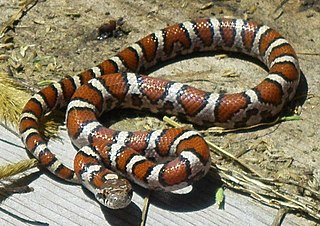
Lampropeltis triangulum triangulum, commonly known as the eastern milk snake or eastern milksnake, is a subspecies of the milk snake. The nonvenomous, colubrid snake is indigenous to eastern and central North America.

Lampropeltis triangulum syspila, commonly known as the red milk snake or red milksnake, is a subspecies of the milk snake (Lampropeltis triangulum). The nonvenomous, colubrid snake is indigenous to the central United States.

Lampropeltis mexicana, the Mexican kingsnake, is a colubrid snake that is endemic to Mexico.
